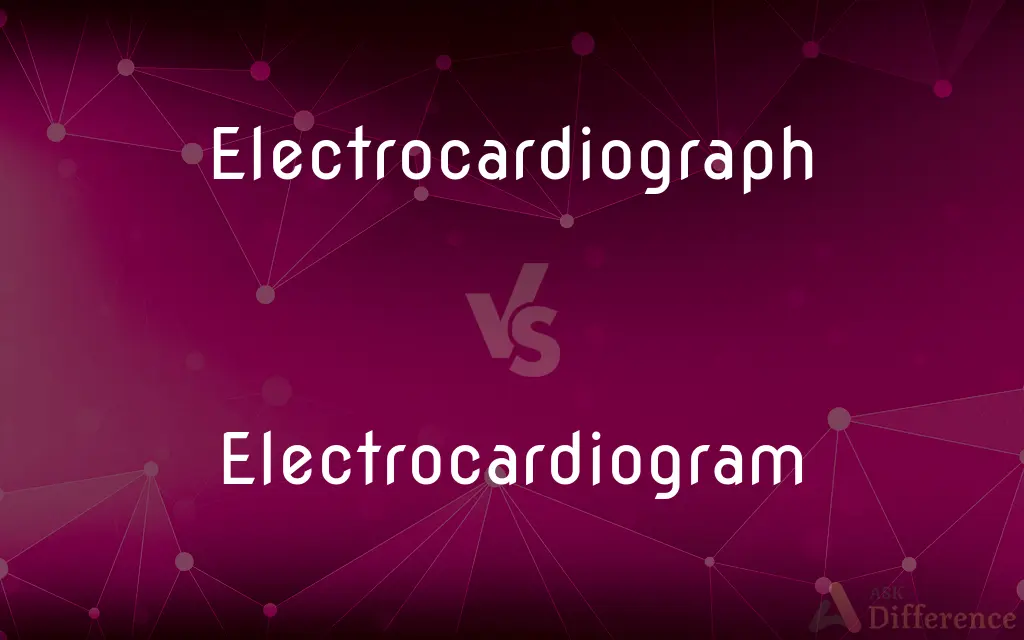Electrocardiograph vs. Electrocardiogram — What's the Difference?
By Maham Liaqat & Fiza Rafique — Updated on March 27, 2024
Electrocardiograph is the machine used to record the heart's electrical activity, while an electrocardiogram (ECG) is the actual record or the graphical representation produced.

Difference Between Electrocardiograph and Electrocardiogram
Table of Contents
ADVERTISEMENT
Key Differences
An electrocardiograph is a medical device designed to capture and record the electrical activity of the heart over a period of time. This device uses electrodes attached to the patient’s skin to detect the electrical changes that occur with each heartbeat. On the other hand, an electrocardiogram, often abbreviated as ECG or EKG, is the graphical output generated by an electrocardiograph. It presents the heart's electrical activity in the form of waves.
The primary function of an electrocardiograph is to monitor and measure the heart’s electrical conduction system. It translates the heart's electrical activities into line tracings on paper or screens. Whereas the electrocardiogram (ECG) serves as a diagnostic tool, enabling healthcare professionals to interpret the rhythm and functioning of the heart by analyzing the waveform patterns depicted in the output.
Electrocardiographs are complex, sophisticated machines found in hospitals and clinics, equipped with sensors and software designed to accurately capture heart activity. An electrocardiogram, however, is a relatively simple representation, consisting of lines and waves that represent the heart’s electrical activity, easily understood by trained personnel.
While the electrocardiograph requires maintenance and calibration to ensure accurate readings, the electrocardiogram itself is a consumable output, often part of a patient’s permanent medical record. The durability and operation of an electrocardiograph are critical for generating accurate electrocardiograms.
Electrocardiographs have evolved technologically, incorporating features like digital displays and connectivity for electronic health records. Conversely, the format and interpretation principles of electrocardiograms have remained consistent, focusing on the heart’s rate, rhythm, and other electrical characteristics important for diagnosis.
ADVERTISEMENT
Comparison Chart
Definition
A device for recording the heart's electrical activity.
The graphical record of the heart's electrical activity.
Primary Function
Captures and records electrical signals.
Serves as a diagnostic tool for interpreting heart function.
Location
Used in medical settings like hospitals and clinics.
Can be reviewed in any healthcare setting or digitally transmitted.
Operation
Requires technical knowledge to operate and maintain.
Requires medical expertise to interpret.
Output
Produces electrocardiograms.
Is the output, depicted as waves and lines.
Compare with Definitions
Electrocardiograph
A medical instrument for recording the electrical activity of the heart.
The hospital recently acquired a new electrocardiograph to enhance cardiac care.
Electrocardiogram
Can be performed during physical exams or when heart disease is suspected.
An electrocardiogram was ordered after the patient complained of chest pain.
Electrocardiograph
Used for diagnosing and monitoring heart conditions.
Regular use of an electrocardiograph can help in early detection of arrhythmias.
Electrocardiogram
Used to diagnose various heart abnormalities.
The electrocardiogram indicated the presence of an atrial fibrillation.
Electrocardiograph
A critical tool in cardiology.
The cardiology department’s electrocardiograph is in constant use due to high demand.
Electrocardiogram
Offers insights into heart rate and rhythm.
The electrocardiogram showed a normal sinus rhythm, indicating a healthy heart.
Electrocardiograph
An electrocardiograph consists of electrodes and recording equipment.
The nurse attached electrodes to the patient’s chest, connecting them to the electrocardiograph.
Electrocardiogram
Consists of P, QRS, and T waves representing different phases of a heartbeat.
The peculiar T wave in the electrocardiogram suggested ischemia.
Electrocardiograph
Device that transforms heart's electrical signals into visual form.
The technician checked the electrocardiograph for any signs of malfunction.
Electrocardiogram
A visual record of the heart's electrical activity.
The doctor examined the electrocardiogram for any abnormal patterns.
Electrocardiograph
A machine used for electrocardiography.
Electrocardiogram
A record or display of a person's heartbeat produced by electrocardiography.
Electrocardiograph
An instrument used in the detection and diagnosis of heart abnormalities that measures electrical potentials on the body surface and generates a record of the electrical currents associated with heart muscle activity. Also called cardiograph.
Electrocardiogram
A graphic record of heart muscle activity recorded by an electrocardiograph.
Electrocardiograph
A device used in the diagnosis and detection of heart abnormalities that measures electric potentials on the surface of the body and creates a record (electrocardiogram) of the electrical currents associated with heart muscle activity
Electrocardiogram
The procedure performed to produce such a record. In both senses also called cardiogram.
Electrocardiograph
Medical instrument that records electric currents associated with contractions of the heart
Electrocardiogram
(cardiology) The visual output that an electrocardiograph produces.
Electrocardiogram
A graphical recording of the cardiac cycle produced by an electrocardiograph
Common Curiosities
Can an electrocardiogram detect all heart problems?
While it's crucial for diagnosing many heart conditions, it cannot detect all heart problems.
What is an electrocardiograph?
An electrocardiograph is a medical device used to record the electrical activity of the heart.
What does an electrocardiogram show?
An electrocardiogram shows the heart’s electrical activity as waves, indicating heart rhythm and other conditions.
How does an electrocardiograph work?
It captures electrical signals from the heart using electrodes and converts them into visual forms on a screen or paper.
Who interprets an electrocardiogram?
Medical professionals like cardiologists and general physicians interpret electrocardiograms.
Do electrocardiographs vary in complexity?
Yes, there are basic models for routine screenings and advanced versions for detailed analysis.
Can physical activity affect electrocardiogram results?
Yes, physical activity can influence heart rate and rhythm, impacting results.
How long does it take to perform an ECG?
The process is quick, usually taking only a few minutes.
Is an electrocardiogram painful?
No, it's a non-invasive and painless procedure.
What can cause abnormal results on an electrocardiogram?
Conditions like arrhythmias, heart attack, and others can cause abnormal ECG results.
Is an electrocardiogram the same as an EKG?
Yes, ECG and EKG refer to the same test, an electrocardiogram.
Can I have an electrocardiogram at home?
Yes, portable devices allow for basic ECG monitoring at home.
How often should one get an electrocardiogram?
It depends on individual health conditions and doctor’s advice.
How is an electrocardiograph maintained?
Regular calibration and maintenance are required to ensure accurate readings.
Are there risks associated with electrocardiographs?
The test itself is safe; the main risk involves interpretation errors.
Share Your Discovery

Previous Comparison
Revenge vs. Vengeance
Next Comparison
Fleece vs. SherpaAuthor Spotlight
Written by
Maham LiaqatCo-written by
Fiza RafiqueFiza Rafique is a skilled content writer at AskDifference.com, where she meticulously refines and enhances written pieces. Drawing from her vast editorial expertise, Fiza ensures clarity, accuracy, and precision in every article. Passionate about language, she continually seeks to elevate the quality of content for readers worldwide.














































